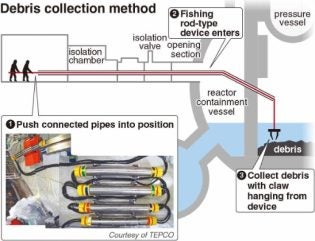
Tokyo Electric Power Company Holdings Tepco has begun a two-week operation to retrieve the first sample of melted fuel debris from inside the damaged reactor at unit 2 of the Fukushima Daiichi NPP.
Three reactors at the NPP suffered a reactor meltdown after the March 2011 earthquake and tsunami. The debris is a mixture of molten nuclear fuel and parts of the reactor structure. Removal of the debris has proved challenging, requiring the development of a special robotic arm to extract radioactive fuel, metal cladding and other structures from the reactor.
The operation was initially scheduled to begin on 22 August but was suspended when workers noticed that five 1.5-metre pipes to be used to push the robot into the reactor had been arranged in the wrong order, Tepco said. The equipment has since been reassembled in the right order.
Tepco originally planned to begin retrieval of the debris in 2021 but delayed the start of procedure pending development of the technology and regulatory approvals. After three postponements, Tepco decided to use the fishing rod-type device, which had been used in previous internal inspections.
About 880 tonnes of fuel debris remain in the three reactors that suffered a meltdown, according to estimates by the International Research Institute for Nuclear Decommissioning. This initial demonstration will retrieve less than 3 grams of the material, which will be analysed for its composition and hardness, providing essential data for the full-scale removal process. If a sample of melted fuel is retrieved Tepco plans to analyse its structure and characteristics at a research facility in Ibaraki Prefecture.
Tepco previously used small robots to examine the inside of the reactors, but this is the first attempt to collect a sample of the melted debris. Once inside the reactor vessel, the robot is operated remotely from a safer location. The robot, nicknamed Telesco can extend up to about 22 metres, including the pipes pushing it from behind, to reach the melted fuel mound, where it will use tongs to collect the sample.
Chief government spokesperson Yoshimasa Hayashi noted that the mission marked the start of the most difficult phase of the Fukushima Daiichi clean-up. “The government will firmly and responsibly tackle the decommissioning until the very end,” he said. The government and Tepco plan to decommission the plant by 2051.
Tepco has launched a special portal detailing the fuel removal process including the initial abortive attempt and the reorganisation of the five push pipes. It includes photos and videos as well as explanatory diagrams.






